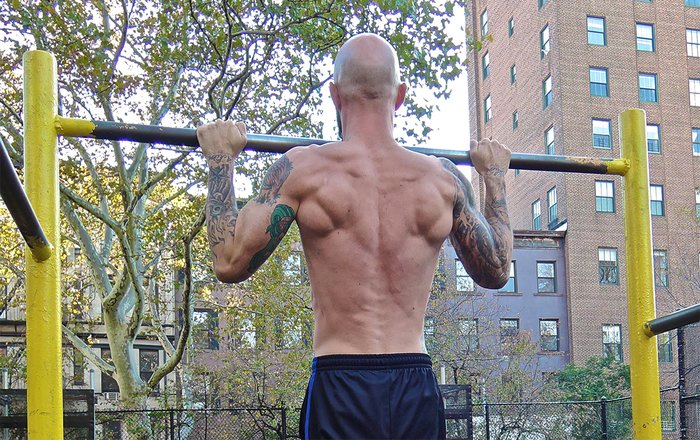If you want to get big and strong, you have to deadlift, right?
The dogma surrounding this lift is so pervasive in gym culture that any attempt to question it is usually met with contempt. That's why even folks who've switched from a weight-training routine to practicing bodyweight calisthenics are sometimes hesitant to set down the barbell and step away from the platform.
But is the deadlift really untouchable? I don't think so. By breaking down this classic powerlift and analyzing the benefits it provides, you can find bodyweight alternatives that fit the bill—and even do a few things the deadlift doesn't!
No Deadlifts? I'm Dead Serious
The most common reasons people cite for deadlifting include better back strength, increasing power in the legs and hips, and building an iron grip. Then there are those of us who just want to look like and feel like a badass.
Those are all perfectly valid pursuits, but what if you don't have access to a gym or weights?
Let's break down each of those goals and consider some alternative options that provide the same benefits without relying on any equipment beyond a basic pull-up bar.
Back Strength: Pull-ups and Back Bridges
It's no secret that pull-ups are the king of upper-back exercises; that one's a no-brainer. As for the lower back, variations of the bridge not only strengthen your lumbar region and entire posterior chain, but also provides a fantastic stretch for the front of your body.

I know what you're thinking: "A bridge? There's no way that an unweighted spinal bend belongs in the same conversation as heavy deads." But give the back bridge a shot before you write it off! It can be surprisingly challenging, even for a veteran lifter, and if you put in the time to get good at it, you'll be rewarded with a spine that is strong, supple, and pain-free all the way from the neck to the hips. Plenty of deadlift fiends manage the "strong" part, but "supple and pain-free" eludes them for years.
To perform a back bridge, begin by lying on your back with your knees bent, feet flat, and hands placed palms-down next to your head. Press into the floor with your hands and feet, arching your back to extend your chest forward and raise your hips into the air. Over time, aim to get your elbows fully locked in the top position (though a partial bend is acceptable when starting out).
Do your best to keep the arc of your spine even throughout and not too heavily pronounced in the lumbar region. If your upper back is stiff, which is quite common, you'll need to be especially mindful of this. It will take time to become better at this move, but it pays off immensely.
Leg and Hip Strength: Single-Leg Squats
There are many types of single leg squats, but the pistol squat is the gold standard. It's also a great way to build tremendous leg and hip strength without weights while incurring unique benefits that the deadlift doesn't provide. The pistol is much more than a pure strength exercise; it represents the perfect combination of strength, balance, flexibility, and control.
To perform a pistol squat, stand upright and reach one leg into the air with your knee straight, then squat down as low as possible on your standing leg. Pause briefly at the bottom, keeping tension in your abs, then return to the top position.
Don't be surprised if you feel your nonsquatting leg during a pistol; you will need to engage your hip flexors and quads on that side in order to keep your leg in the air. The term "single-leg squat" can be a bit misleading!
Another worthwhile variation is the one-legged shrimp squat. This time, the nonsquatting leg will be held behind your body rather than in front. The change in position can elicit even more activation from the hips, glutes, and hamstrings of the squatting leg.
To perform a shrimp squat, grasp one foot behind your back, then bend from the hip, knee, and ankle of your nonsquatting leg, carefully lowering until your back knee reaches the ground. Pause there briefly, then press into the floor with your grounded foot, and tense your abs to return to a standing position.
When performing single-leg squats, it's common for one side to be stronger than the other, so remember to practice evenly on both legs. In fact, you can actually use this exercise to work toward eradicating muscle imbalances by prioritizing your weaker side.
Grip Strength: Single-Arm Hangs
Hanging from just one arm is a fantastic way to build your grip. Think about it: The grip strength needed for a single-arm hang is basically equal to using both arms to hold double your body weight.
Start by gripping an overhead bar with two arms, then carefully take one away. Make sure to squeeze tightly and stay engaged through the scapula of your hanging arm. Don't allow your chin to collapse into your chest.
At first, you may manage only a few seconds, but with practice, you can work up to hanging for a minute or longer from one arm. As with single-leg squats, make sure to practice your single-arm hangs evenly on both sides.
Full-body Tension and Looking Like a Badass: Back Levers
Though the back lever and deadlift may not appear to have much in common on the surface, they're actually quite similar. In fact, the back lever may be the closest way to replicate the effects of the deadlift without any external weight.
Just like the deadlift, performing a back lever requires tremendous strength in the entire posterior chain as well as the grip. While it's probably obvious from looking at the back lever that it requires a lot of upper-body strength, you might be surprised how much the glutes and hamstrings are involved here as well.
The first step toward learning the back lever is to hang from a pull-up bar, lift your knees to your chest, and thread your legs around to the other side. This move is sometimes known as "skinning the cat." From there, work toward pitching your chest forward and extending your legs straight behind you so that your body forms a straight line, almost like you are flying through the air.
Besides looking cool, the back lever is a fantastic way to build total-body strength while learning to engage your entire musculature as a single, cohesive unit.
Dead End?
I'm not here to decry the deadlift. In fact, there are many valid reasons that it continues to be a strength-training staple. However, the best thing about these exercises is that nobody is forced to choose between them. Deadlifts and bodyweight calisthenics can peacefully coexist within the same program. In fact, you might even find that incorporating these moves into your strength regimen can improve your strength across all modalities—including the deadlift.
At the very least, you can keep these calisthenic deadlift alternatives up your sleeve to make sure you have a full, balanced program—or if should you ever find yourself in a situation where there's nothing around to lift but your own body weight!
For more information on advanced calisthenics training, grab a copy of Al's latest book, Street Workout.

